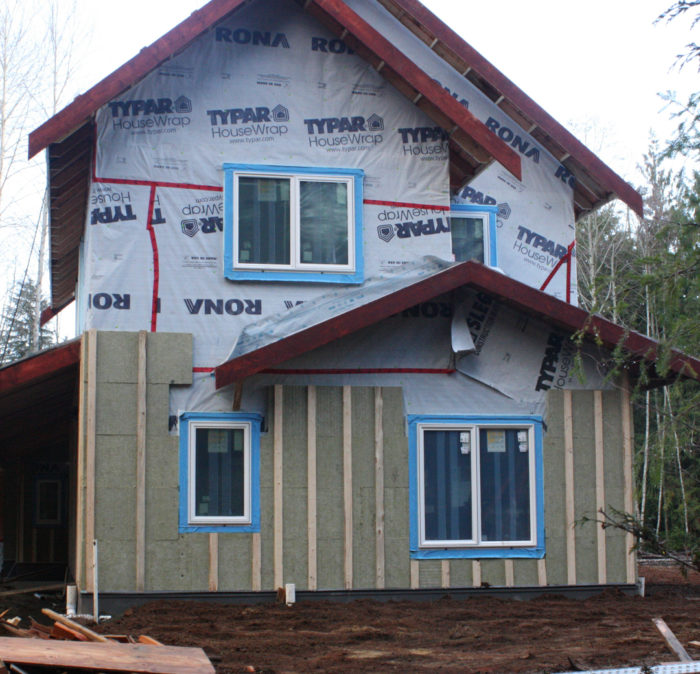
Image Credit: All photos: Shannon Cowan and Patrick Walshe
Image Credit: All photos: Shannon Cowan and Patrick Walshe We chose to use 2-inch thick Comfortboard IS; the product is also available in other thicknesses. A continuous layer of rigid mineral wool insulation on the exterior of the house helps reduce thermal bridging. An owner/builder in Alberta is looking for the guidance on how to attach board-and-batten siding to the assembly. Photo courtesy Shannon Cowan and Patrick Walshe. The builders adjusted the furring-strip screws as necessary to ensure that the furring strips were plumb and co-planar. This photo shows the metal channel installed under the bottom course of mineral-wool insulation. The wall was trimmed with corner boards and a water table.
As the landscape around our building site disappears under a rare blanket of snow, the sheathing on our houses has been disappearing under a thick layer of exterior mineral-wool insulation. Known as Comfortboard IS, this insulation has impressed us with its green virtues, versatility, and price.
Made in Canada by Roxul, Comfortboard is one product in a line of “stone wool” products that combine the power of rock with the characteristics of insulation wool. Originally inspired by the way wind spins molten lava into fibrous material during a volcanic eruption, stone wool is fire-, mold- and insect-resistant. It’s also water-repellent. This latter feature is attractive in the Pacific Northwest, where building tends to happen year ’round despite the weather.
Comfortboard also has excellent thermal properties. The 2 inches of Roxul we installed will add R-8.4 to our walls. (Comfortboard is also available in thinner and thicker boards).
Exterior insulation keeps the sheathing warm
While our staggered stud wall has less thermal bridging than many standard walls, the 2×10 top and bottom plates and rim joists do have some. This exterior insulation helps reduce heat loss in those places and brings the weakest parts of the wall (aside from windows and doors) up to R-20. (The 2×10 wall plates have an R-value of about R-11.6, and 2 inches of Roxul has an R-value of R-8.4.) This level of insulation is better than the average for most 2×6 stud wall systems.
Most of our wall assembly has a higher R-value, of course. The walls will have 9 1/4 inches of cellulose insulation (R-32) plus the exterior mineral wool insulation, for a total of about R-40.
Mounted on the exterior like rigid foam, Comfortboard mineral wool has the added benefit of allowing walls to dry out to the exterior (research on this topic is available at the Building Science Corporation website). It helps prevent condensation on the inside of the sheathing by keeping it warm most of the time. (You can use some rules of thumb to figure out what R-value you should have on the exterior of the sheathing — the information is available in an article titled Calculating the Minimum Thickness of Rigid Foam Sheathing — though the minimum thicknesses listed for foam are not as vital for mineral wool, which is more vapor-permeable than rigid foam.)
Comfortboard is made of natural, inorganic materials and has a high recycled content. The manufacturer has invested deeply in emission reductions and other green initiatives that help offset the energy used during production. Mineral wool generally has a minimum recycled content of 75%, making products in this category a nice alternative to petroleum-based foams and their greenhouse-warming blowing agents and flame retardants.
Recently, some green builders have expressed concerns over reports that Roxul mineral wool products may contain formaldehyde. When we sent an inquiry to Roxul about the formaldehyde question, a company spokesperson responded, “Although a formaldehyde-based organic binder is used during manufacturing, a high-temperature curing phase virtually eliminates volatile compounds. The result is no measurable free-form formaldehyde in the final product and no volatile organic compounds that can off-gas.”
Initial installation concerns
Initially we were concerned that installation would be tricky due to the softer nature of the Comfortboard. It’s less rigid than foam; its compressive strength is about 5 psi, compared to 25 to 30 psi for common types of rigid foam. It truly feels like a thick wool blanket.
Our builders shared some of the same concerns. Gerard Dubenski of Big Coast Construction, working with Penbay Construction in Nanaimo, British Columbia, led the crew who installed the product. None of them had ever used Roxul Comfortboard before. “Comfortboard is softer than foam, but we found that cap nails helped to consistently prop out the strapping at the required distance from the sheathing,” he said when interviewed at our building site.
Dubenski and his crew attached the insulation with 2 1/2 inch cap nails tapped in by hand until they were flush with the surface of the Comfortboard. They installed these nails in vertical rows over the studs, which are 16 inches on center. The vertical spacing between nails was 24 inches, so that each 2’ x 4’ piece of Comfortboard (installed with the 4-foot dimension running horizontally) had one nail per stud.
In addition to securing the Comfortboard, the nails helped to mark the studs for later installation of the rainscreen strapping (which was anchored to the studs).
Adjusting the furring strips to be sure they’re plumb and co-planar
When adding the 1×4 strapping over the Comfortboard, Dubenski and crew placed one screw at the top and and once screw at the bottom of each furring strip, and then checked it with a long level to be sure it was plumb before adding the remaining screws. “Once we got the hang of it, we didn’t need to fiddle around much backing screws out,” Dubenski said. “We also took care when installing the fiber-cement siding to make a few adjustments.”
Now that the installation of the Comfortboard is almost complete (and with more than half of the siding on), Dubenski has a better understanding of the product. He cites a few challenges that arose when mounting boxes for penetrations through the wall. “We installed solid wood backing in places as needed, such as around doors where we wanted to install security screws,” he says. “Now that we’ve worked with it, I can only see it as being easier and easier because we have worked out methods for using it.”
Dubenski sees many benefits to mineral wool. “We liked it more than foam. It was easier to cut with a large utility knife or bread knife. We also took pieces [of mineral wool] and submerged them in the pond as a test, because we were so worried about the wall being soggy. The water beaded off. As it turns out, the Roxul will actually help keep the wall dry.”
Dubenski recommends the product for a variety of applications, including renovation jobs where the siding is stripped and the owner wants more insulation. “You could do it from the outside without any inside mess. I was definitely skeptical at first, but I am sold on it now. I will definitely use it again.”
What about window flashing?
Because Comfortboard is made from fuzzy mineral wool, it’s difficult to attach tape or peel-and-stick to its surface. For this reason, our builder and architect advised us to install “picture-frame” strips of 2-inch-thick XPS foam around each window — just enough to nail the window flanges to, and to provide a surface for sealing the rough openings with peel and stick membrane.
We’ll provide further details on our approach to window flashing in an upcoming blog.
It won’t rot and it won’t support mold
As owners who have watched the construction progress, we have been impressed by the versatility of Comfortboard IS. Its green points are important to us. The product’s affordability adds to its appeal, since it costs about the same as XPS foam.
“I’m a fan of mineral wool because it doesn’t settle, doesn’t rot even if continually wetted, is fireproof, and won’t support mold or bugs,” summed up Albert Rooks. (Rooks was quoted in Scott Gibson’s article, “Choosing a Cost-Effective Wall System.”) “It’s like a little piece if the Canadian Rockies (since it’s made of Canadian basalt) covering your house, and nearly as durable.”
Not that we need convincing: with this rare snowfall, we can see some of the benefits first hand. And we look forward to enjoying the other benefits down the road.
Shannon Cowan and Patrick Walshe are building an energy efficient, multi-family house in Qualicum Beach, British Columbia. They chronicle this and other adventures in sustainable family living at their blog, A Green Hearth.
Weekly Newsletter
Get building science and energy efficiency advice, plus special offers, in your inbox.




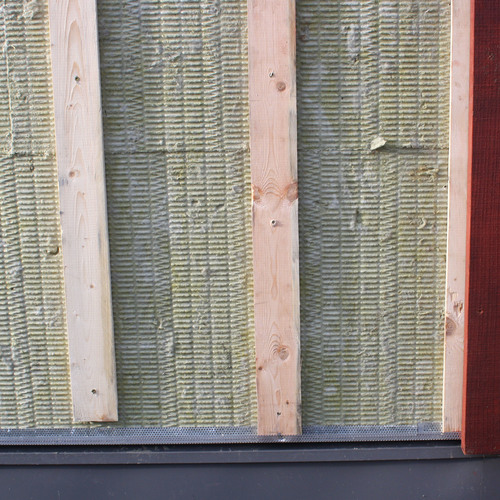
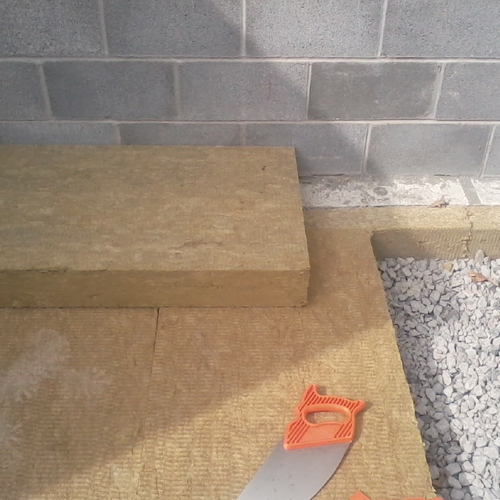
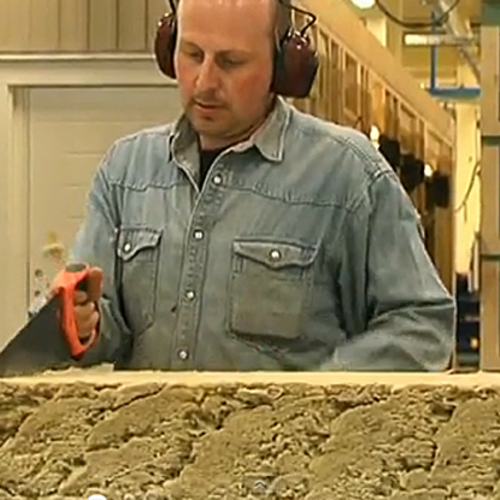
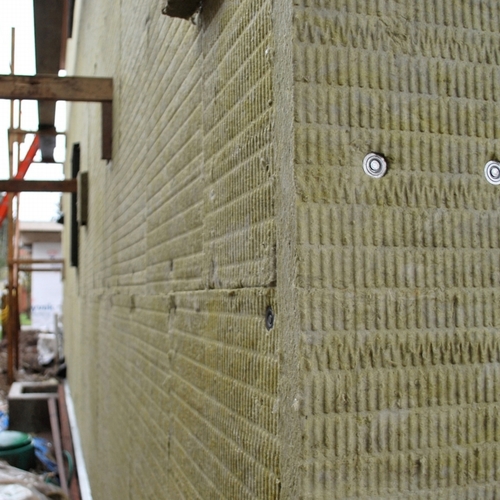






33 Comments
Performance
You may also be interested to know that early results from independent field tests are showing better thermal performance in cold weather (per nominal R-value) than XPS and Polyiso. With the added benefit of allowing the wall to dry to the exterior, this option is looking better and better.
I'm a fan!
I installed 1-1/4" Roxul "drainboard" on the outside of my own house. I used a high vapor permeable air/water barrier (VaproShield) with taped seams under the Roxul. Over the Roxul, I used 1/2" plywood furring strips attached with wood screws. The Roxul boards were just tacked up with roofing nails, until I could get the furring strips over the Roxul. The Roxul compressed +/- 1/4" at each furring strip, but I felt better about the rainscreen/siding assembly knowing that the furring strips were firmly in place. I set the windows out 1-1/2" on wood "out-y" boxes, and flashed around the boxes. The Roxul was easier to work with than EPS: more malleable and easy to cut with just a serrated knife.
While EPS board insulation may have a higher R/inch, it doesn't drain as well as Roxul. Walsh Construction in Portland (OR) did a study of several different wall assembly types in our region (Northwest). It found that, while any exterior insulation helped to bring the dew point outside of the sheathing, mineral wool board exterior insulation combined with a vapor permeable air/water barrier allowed any moisture in the assembly to dry to the outside during our warmer months. In mixed climates, and especially mixed moderate climates, it makes sense to give the assembly an opportunity to dry to the outside.
Some have argued that so long as the dew point is outside the assembly, why bother with vapor permeability. But in wood frame construction, with a hybrid stud cavity insulation and exterior board insulation, and building in wet region like the northwest, the potential to dry to the outside is the way to go.
Wind washing
If there any issue with wind washing and corresponding loss in R value due to no housewrap covering the Roxul?
Re: Wind Washing
John -
It doesn't appear to be an issue in my test walls. They are constructed like the house above - with a rain screen cladding (3/4 inch vertical strapping and fiber cement lap siding) and are exposed to natural climatic conditions. The main difference is that I used two layers of 1 1/2 inch IS board. While this product can't stop air movement at a micro level, the density of the product definitely stops the bulk movement of air - unlike low density fiberglass or rockwool.
If there is any wind washing effect, it is very small as the IS walls are thermally outperforming the XPS and Polyiso walls of the same construction and same rated R-value - both of which are air impermeable.
Trevor
BTW - this is an Engineering Master's thesis project. I don't work for or make money from any manufacturer
? Insect screen between the furring strips
I don't know what the insect population is in the pacific northwest, but I am curious if there is going to be an insect screen between the furring strips. Also where do you get the screen that is shown at the bottom of the rock wool?
We're kind of buggy in the Southeast so I know I would need an insect screen at the base of the furring strips. Well, seriously buggy (as in insects) in the Southeast.
I really appreciate the homeowners sharing this information. I also am interested in Trevor's research. Thank you.
Lucy
Very cool. About the staggered studs on the 2x10:
Are they 16" O.C., both inside and outside? Are both inner and outer studs load-bearing? Why did you decide not to put up two 2x4 walls side by side? (I guess you're going to cover the window framing in your next posting.)
Insects and Siding
Lucy, while there is no code requirement in BC that you provide insect protection for the rain screen cavity, builders generally either fold screen over the bottom of the furring strips or use a perforated flashing similar to the one visible above the window in one of the photos.
I'm curious as to how the cement board siding was fastened at the windows. Is it nailed right through the foam surround into the sheathing?
Very interesting project. Especially for those of us with reservations about using foam.
@Lucy
Lucy, we don't have nearly as many bugs in the Northwest, but we have our share! I just looked up this video on GBA. It shows how they put on the insect screen at the bottom of the wall.
https://www.greenbuildingadvisor.com/video-how-install-rigid-foam-insulation-outside-house
insect screen at bottom of wall, double wall vs staggered stud
Hi - we did put perforated screening over the bottom of the strapping just like the roxul one in the photo. Later we got the right size that would encompass both the roxul and the strapping with one piece. Since we were paying extra for the thick wall and exterior insulation, with out tight budget we compromised by making the wall faster to build. We used a panelized construction method and it was easier for them to assemble one wall and put it up once. With our mild coastal climate we are not worried too much about a couple of strips of R20. The foam was just wide enough for the cedar window trim. The siding was nailed to strapping.
staggered stud spacing
Malcolm, the studs are 16" centers inside and out so they would share the load. I recall some folks with double walls use 24" spacing on the inside wall.
window flashing post is up at agreenhearth
Our window flashing post is now up at http://agreenhearth.com/our-lessons-in-window-flashing/. I will add a side profile diagram that more clearly illustrates the layers.
Roxul Board as Thermal Bridge Block
We have just completed a passiv style house in Delaware and put Roxul on the inside and outside--1.25 inch thick. At this thickness we felt okay about nailing the siding right through with hydrogap rain screen house wrap, and then screwing the drywall right through. The only framing required was building out the window on both sides. The binders in Roxul keep the fibers down which is nice. It is very permeable so it doesn't hold water. We put the hydrogap over the roxul. And we nailed Nichiha siding right through with ring shank stainless steel nails. So far, so good. It is easily cut with a razor knife. With sprayed cellulose the r-value was R-32. And obviously sealing at the outside corners is critical in any air barrier--like at the roof wall connection.
John, why did you put
John, why did you put hydrogap over the Roxul? I would think you'd want the drainage plane behind the MW, especially since it's water/insect/UV proof (resistant?).
Also, in the article, I though it was interesting that peel-and-stick was used on the outside of the exterior insulation rather than on the sheathing itself. If you had to then use a plywood box frame at the windows, but leave the exterior insulation completely separate (and outside of) the flashing.
Lastly, is comfortboard available in the US (Seattle area, specifically)? Roxul direct's me to Home Depot but they only list the batts. Anyone?
Insect screen and Availability
I'm going commando without an insect screen. My rainscreen air gap is only 1/4-1/2" and it's been up about a year. I haven't noticed any more insects than are typical in a older neighborhood in a northwest city. We'll see, maybe I'll have a hellish summer of fighting off wasps. I suspect that if the air gap were greater, I'd go for the customized perf panel that the author looks like he used.
Regarding availability of semi-rigid Roxul products. There is a Roxul rep in western Washington whom I met with while designing commercial buildings in the Seattle area. He referred me to SPI. They're an industrial supplier but were happy to sell me product for my residential project. They stocked limited sizes/thickesses and not all the products Roxul offers on their website. But for a big enough project, and/or with enough effort, you can probably get any of the Roxul semi-rigid products from SPI. It's worth talking to Roxul directly, as many of their products are pretty similar, just minor modifications of binder content and/or density. That's how I ended up using their drain board product in a rainscreen application. SPI does not sell Roxul's batt products. I was able to find Roxul's ComfortBatt stocked at McClendon's Hardware. All the big box stores can order it, as well as your local lumber co. While I prefer dense-packed cellulose for cavity insulation, mineral wool batt is great for acoustic insulation in stud cavities. And it has great fire resistant properties.
FYI. I'm an architect without a horse in the race. There are other mineral insulation mfr's out there that are probably more readily available in other parts of North America. It just happens that Roxul is the only one I've found who's made an effort to sell in the BC and NW area.
Roxul Comfortboard IS availability
My local builder supply store can order Roxul comfortboard IS - just allow a few weeks for that. I imagine that any place that sells roxul batts could easily order some of the comfortboard. I have not seen it stocked locally. My contractor desk agent quoted me $1.09 Canadian per square foot for the 2" 4x6 boards we used.
Pablo, the mineral wool would
Pablo, the mineral wool would be tacked to the outside of the sheathing and over the top of the mineral wool (and NOT compressing into it) would be the furring strips. Longer screws are used to go through the furring strips, the MW, the sheathing and embed a min. 1-1/4" (I think) into the stud itself.
If I understand the article correctly, the cap nails were used to keep the furring strips from compressing the MW.
The siding would be screwed into the furring strips only. "sliding down" shouldn't be an issue if it's installed correctly.
Hope that helps.
furring strips
it seems a very interesting material.
I´ve actually used similar product to acoustically insulate a room.
my question, I´m not getting how furring strips work.
how do you prevent them from "sliding down" once you nail the siding on them??
are the "flying" screws able to support the whole thing??
(the furring strips barely squeeze the wool, so there won´t be much help there)
thank you much
@ daniel @ pablo (?)
Tthanks Daniel for taking this on.
I understood the article in the same way you did.
My concern is in the screws that hold the furring strips through the MW onto the structure.
Basically, the shaft of those screws will be in the air (the MW won't offer any holding).
that's not the usual way screws are used.
do you think the they will still work fine??
thanks again.
Deflection testing
Pablo - If you are interested, see the link below for a detailed description of the testing BSC has done on this topic.
If you just want to know if it works, the answer is yes.
The screws actually end up in tension before they are able to bend (much) and this supports the furring strips vertically.
http://www.buildingscience.com/documents/reports/rr-1204-external-insulation-masonry-walls-wood-framed-walls/view?searchterm=deflection%20testing
Response to Pablo
Pablo,
There's also more information on testing furring strips over Roxul insulation in another GBA article on the topic: Installing Mineral Wool Insulation Over Exterior Wall Sheathing.
furring strips II
that was great! thank you guys to point me to those reports.
impressive data and research on the subject.
I just skimmed over the report, but was convinced the system works great.
one small note, as far as I went into it, the results for MW might be slightly different than for rigid foam?? in page 19 reads:
"The deflection testing showed that friction between the various layers is reasonably significant in
the development of the system capacity. During most of the tests conducted, slippage between
layers occurred as the vertical load overcame the static friction between the layers."
thank you again
HardiShingle Panels over ComfortBoard + MW "flaking"
I was truly excited to see this approach. I'm looking for ways to maximize insulation of my 2x4 ranch home. Initially, I was convinced that closed cell spray foam was the way to go, but have been frightened off by reports of off-gassing and shrinkage.
Three questions/concerns come to mind.
1) Can this system be installed on the ends of my home that do not have an overhang (soffit)? The side wall would end up sticking out further than the drip edge of my roof.
2) Can I install HardiShingle Panels over the furring strips? With the large gap between the strips, there is a large portion of the fiber cement that would not have a firm backing. I think that would make the fiber cement vulnerable to cracking (for example, if hit with a basketball).
3) Can the bottom of the drainage spaces become clogged with Roxul fibers? I've used Roxul insulation in a small area of my home and it has a tendency to flake or powder off (I've heard people describe its composition as similar to a stale hotdog bun). I'd be tempted to put house-wrap or window screening over the ComfortBoard.
Thanks in advance for your input.
Response to Steve Kerxhalli
Steve,
I'll tackle one of your questions.
Q. "Can this system be installed on the ends of my home that do not have an overhang (soffit)? The side wall would end up sticking out further than the drip edge of my roof."
A. No. Every wall needs a roof. If your wall ends up proud of your eave, you'll have to extend your roof.
Current Availability Near Denver
Just as an assist to others looking to use ComfortBoard in the Colorado area, it looks like PrimeSource (who has the exclusive distributorship for Roxul in the US I believe) in Denver can sell ComfortBoard IS in at least 2" and 3" 2x4 or 3x4 panels. It didn't seem like I could get DrainBoard (the 2 3/8" R-10 product) or the roofing products (TopRock or MonoRock). Supposedly if you avoid special order items (that's how you could probably get those other products) you can combine with other Roxul shipments to order less than a full truck (full truck is on the order of 13k sf). Pricing looked to be a little less than $2/sf for the 2" product and <$3/sf for the 3" product. Talk to your local Home Depot Pro Desk but be prepared for some effort. This took me about 5 tries which is why I'm sharing the info in detail. Cheers.
For installing siding on furring strips over Comfortboard, is there any specific recommendation about the type of *cladding* fastener to be used? There are specific recommendations for fasteners used to attach the furring strips, but I've not found guidance on this other aspect from Roxul. Is there any concern about use of nails, where the hammer blow could deflect the furring and compress the insulation permanently underneath. Screws would obviously avoid this problem if it exists.
Richard,
The type of nail will depend on the type of cladding, but in all cases it's a lot easier to use an air-nailer.
Thinking about building with 3/4 inch OSB on interior walls to act as vapor and air barrier in climate zone 4b. Can this product be installed directly to studs on exterior with house wrap on top and then furring strips for rain screen behind siding? Does anybody see a problem with this?
Why deviate from wall assemblies that are known to work?
https://www.greenbuildingadvisor.com/article/walls-that-work
The general concept im speaking of is a wall that works and probably is a much better wall design in cold climates as it easily dries to the outside. Its common practice in switzerland. Im just seeking advise as to whether rockwool comfort board can be installed directly to studs and if there are any downsides to this method.
Stanfo3,
It's possible. The difficulties I can think of are:
- Sequencing. When does the interior OSB go on? During framing for stability? Before interior walls? If so, how do the exterior walls get electrical and plumbing run? If it's a back and forth thing, you need to get both the sub-trades and inspectors onside. They typically like to compete the framing in one go, not stages.
- Continuity of structure. The sheathing does not provide continuity between floors. In many places, that lack will necessitate some supplemental hardware to tie things together.
- All cavity insulation has to be applied from the outside, making construction very weather dependant.
- Unlike using exterior sheathing, the air-sealing will have a lot of transitions, at floor framing, small wall penetrations, etc.
- Integrating both small and large openings with the WRB with no backing will be difficult.
- Attaching the three exterior layers, especially on a two story house without sheathing will be a challenge. You can't work off a ladder, so complete access for either scaffolding or a bucket truck is necessary.
- How does the flashing at the base, transitions and openings get integrated with the framing and WRB, which is outboard of the mineral wool? For instance, how does the bottom of the insulation and cavity get covered and attached to the house-wrap?
It's all doable, but seems to introduce a level of complexity and fragility to the build that to me is disproportionate to the benefits. If asked to bid on a house with this assembly, I'd pass.
Does anyone have any tips on where to find that perforated aluminum channel that is used? I can't find this anywhere locally in Northern Wisconsin at an even remotely reasonable cost.
Michael,
Try Menzies Metals: https://www.menzies-metal.com/metal-flashings/perforated-j-channel-rain-screen-low-back/
Yeah most of this stuff including PowerWool (another brand) is available at http://www.warehoos.com . A pretty good source for hard to source building products of all kinds actually.
Log in or create an account to post a comment.
Sign up Log in